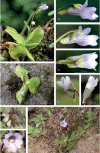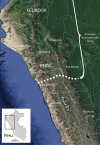Pinguicula rosmarieae Casper, Bussmann & T.Henning (Lentibulariaceae), a new butterwort from the Amotape-Huancabamba Zone (northern Peru)
- PMID: 32194317
- PMCID: PMC7066261
- DOI: 10.3897/phytokeys.140.49529
Pinguicula rosmarieae Casper, Bussmann & T.Henning (Lentibulariaceae), a new butterwort from the Amotape-Huancabamba Zone (northern Peru)
Abstract
The insectivorous genus Pinguicula occurs along the whole Andean mountain chain from Colombia-Venezuela in the north to Tierra del Fuego in the south with a short interruption in the Peruvian-Chilean desert range. This paper describes a new and striking species of Pinguicula that occurs in the south-eastern part of the Amotape-Huancabamba Zone in north Peru. It grows either as a lithophyte on moist rocks or as an epiphyte on Polylepis multijuga Pilg. in the wet highlands of the Cordillera Central. Pinguicula rosmarieae Casper, Bussmann & T.Henning, sp. nov. is clearly distinguished by a basal rosette of ovate-obovate leaves spread out flat on the ground and especially by a two-partite corolla with a straight uniform tube-spur complex, two features unknown from other Andean Pinguicula species. The morphological similarity to P. calyptrata Kunth is discussed and the habitat and distribution of P. rosmarieae are characterised.
ResumenEl género insectívoro Pinguicula se encuentra a lo largo Andes desde Colombia y Venezuela en el norte hasta Tierra Fuego en el sur, con una breve interrupción en el los desiertos peruano-chilenos. Este artículo describe una nueva y distintiva especie de Pinguicula que se encuentra en la parte sur de la zona Amotape-Huancabamba en el norte del Perú. Puede crecer tanto como litófita sobre rocas húmedas o como epífita sobre Polylepis multijuga Pilg. en las tierras altas y húmedas de la Cordillera Central. Pinguicula rosmarieae Casper, Bussmann & T.Henning, sp. nov. se distingue claramente por tener una roseta basal de hojas ovadas-obovadas, postradas sobre el suelo y, especialmente, por la corola bipartida con un espolón uniforme recto, una combinación de características desconocidas de otras especies andinas de Pinguicula. Se discute la similitud morfológica con P. calyptrata Kunth y se caracterizan el hábitat y la distribución de P. rosmarieae.
Keywords: Lentibulariaceae; Pinguicula; Amotape-Huancabamba Zone; Cordillera Central; Peru; Pinguicula rosmarieae; distribution; endemic; new species; taxonomy.
S. Jost Casper, Rainer W. Bussmann, Tilo Henning.
Figures




References
-
- Ayers T. (1999) Biogeography of Lysipomia (Campanulaceae), a high elevation endemic: An illustration of species richness at the Huancabamba Depression, Peru. Arnaldoa 6: 13–18.
-
- Berry PE. (1982) The systematics and evolution of Fuchsia sect. Fuchsia (Onagraceae). Annals of the Missouri Botanical Garden 69(1): 1–198. 10.2307/2398789 - DOI
-
- Casper SJ, Hellwig F. (2019) The portrait of Pinguicula involuta Ruiz & Pavon in the “Flora Peruviana”: A botanical detective story. Carnivorous Plant Newsletter 48(3): 122–127.
-
- Halda JJ, Heřtus P, Malina M. (2007) Několik nových bolívijských rostlin – Some new Bolivian plants. Acta Musei Richnoviensis Sect. Nat. 14(4): 105–126.
LinkOut - more resources
Full Text Sources
